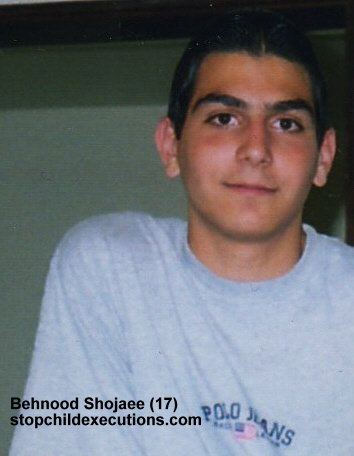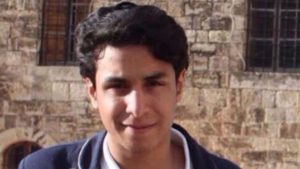
 Behnood Shojaei is executed in Iran on “International Day Against the Death Penalty”
Behnood Shojaei is executed in Iran on “International Day Against the Death Penalty”
October 10th 2009
I lie awake in bed. Tossing and turning thinking of his face. I have just found out the devastating news of the loss of one of our children: Behnood Shojaei.
He is one of 160 children whose lives we have been trying to save for the past few years, but he is not a number. He was a handsome boy with dreams and aspirations. He was a boy at the wrong place at the wrong time, where a fight ensued and another boy was killed. Premeditated? No. Accident? Yes. Self-defence? Perhaps. We will never know exactly what happened that day but what we do know is that he was 17-years -old when the incident took place. He was a juvenile and under international treaties that Iran has signed, it is against international human rights law to execute ANYONE who has committed an offence before the age of 18. He was a boy who escaped the hangman’s noose five times. Each time, a piece of him died. Each time, the volunteer members of our organization Stop Child
Executions, and other human rights groups fighting for these children, felt a bolt to the heart. Our bruised hearts would heal as we would gain renewed hope that our efforts to pressure Iran had made a difference. We felt like our continuous pleas for urgent action on behalf of the United Nations, European Union, governments worldwide, human rights groups, individuals and especially the selfless and courageous lawyers representing these children, were making a difference. This time we were unsuccessful. This time with the passing of Behnoud Shojaei’s life, as the stool was kicked out from under his legs, our hopes were also asphyxiated.
I called Behnoud’s lawyer Mr. Mohammad Mostafaei who represents dozens of children on death row. The first thing I asked him was “Is it true?”. With a sad, tearful and hoarse voice he confirmed the nightmare. He said that hundreds of people came to the prison gates to pressure for a halt to the execution and to plead with the victim’s family to forgive Behnood. The victim’s mother said that she would wait until they put the rope around Behnood’s neck to decide his fate. Under Iran’s law, in murder cases called “ghesas” crimes, the family of the victim is awarded the right to decide the fate of the accused. The family is allowed to ask for a monetary compensation instead. After deliberations over years, the mother chose “death”. Mr. Mostafaei saw Behnood’s life pass before his very own eyes inside the prison walls. I was in a state of shock as he recounted his story. All I could tell him was how sorry I was and how grateful we all are for his efforts. At times like this, I feel so paralyzed the right words just don’t come out.
To Behnood’s family, to Mr. Mostafaei, to all freedom loving people who want to see an end to human rights abuses in Iran:
I vow that the battle has just begun. Every drop shed by a victim of a crime against humanity committed by the Islamic Republic of Iran will act as a drop of blood which will fuel our actions for change.
As Behnood’s wings have now grown to fly him to the heavens, we too will grow the strength to take on the larger battle of paving the way towards democracy in Iran where a proper judicial system will be in place, where the rule of law exists and where children will be playing and laughing instead of languishing behind bars and mercilessly being killed.
I make this vow. Who will join me?
I pray to God that Behnood’s soul rest in peace and I pray to God that Safar Angooti scheduled to be executed in ten days receive a stay of execution.
Love,
Nazanin
Nazanin Afshin-Jam
President and Co-Founder
Stop Child Executions
More background information on Behnood Shojaei
17-year-old Behnood Shojaee was convicted of killing a 19 year old boy named Omid during a street fight involving over a dozen boys.
Shojaee says that he tried to stop the fight and used a chard of glass from a broken soda bottle in self defence. He said he hit an attacker once only with the piece of glass. Shojaee’s lawyer Mohammad Mostafaei argues that the coroner found several wounds by various objects making it unable to assess who was responsible for the fatal blow causing death.
At first the family of the victim wanted over 2 million dollars US in “blood money” compensation. After months of negotiation, and his execution being postponed three times, the “diyeh” was reduced to approximately $625,000 USD.
Shojaee who grew up with his grandparents since the death of his mother at age 10 from diabetes and a father living with depression from his tragic loss, he could not afford the required “diyeh”.

Three of Iran’s most prominent movie directors and actors ( Entezami, Parviz Parastooyi and Kiymars PoorAhmad) opened a joint account to help raise money for his “diyeh”. In an unprecedented measure, the Iranian judiciary froze the bank account, summoned the artists and threatened that “they shall be investigated and it shall be assumed that they are not aware of the special laws that were passed in 1997 by the State Expediency Council which have strengthened the punishments against corruption, embezzlement, and misappropriation and which carry punishments ranging from one to seven years of prison”.
On May 23rd 2008, in a joint statement, 40 European countries condemned the execution of Behnood Shojaee.
In August 2008 in a press conference in Geneva and one put on by Stop Child Executions in London, 24 human rights organizations demanded Iran to Stop the execution of Behnood Shojaee and Mohammad Fadaee as well as the 132 children on death row at the time.
Just this week the European Union sent another statement condemning Iran for juvenile executions including Behnood Shojaee’s imminent execution, other government officials and invididuals worldwide.



